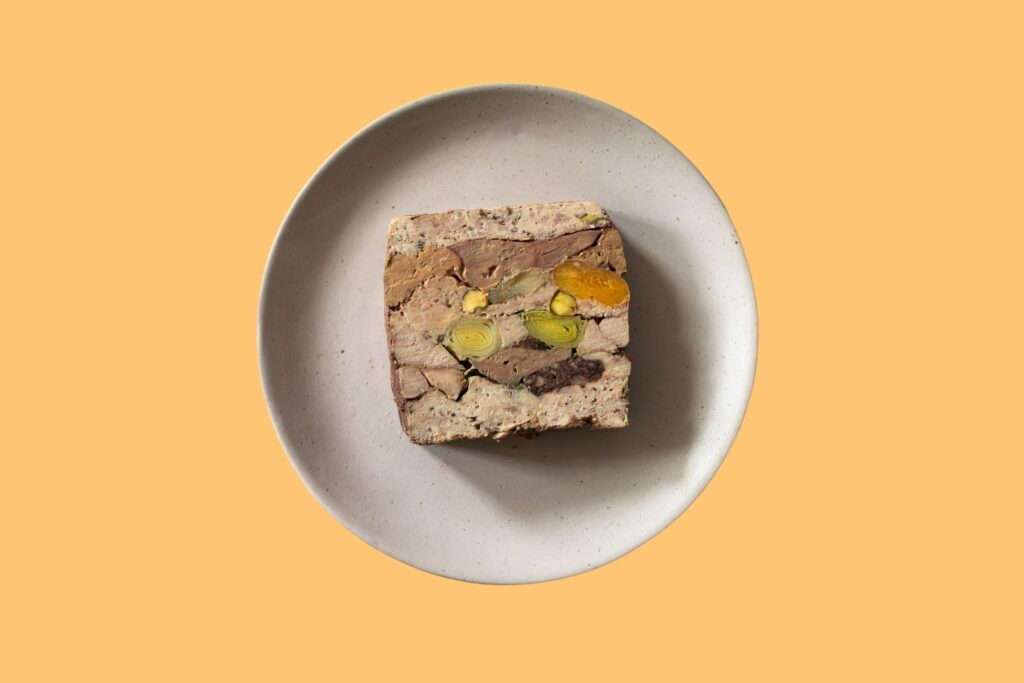It’s one of life’s great existential questions, on a par with ‘Is there a God?’ and ‘What is the purpose of existence?’… Just what is the difference between pâté, rillette and terrine?
Sure, you may have spread one or all of these delicious French charcuterie staples over a crusty baguette or triangle of toast before, all without considering the etymology of the term, but today we’re digging deeper.
We’ve eaten at the best French restaurants, we’ve foraged in the far corners of Google, and we’ve gained several pounds in the process, to bring you this; the differences between pâté, rillette and terrine.
Similarities & Origins
In true analytical style, let’s first take a look at a few similarities between these three delicious dishes.
Whether you buy duck rillettes or pork, enjoy chicken liver or wild trout pâté, or take your terrine with chicken and pistachio or smoked salmon, all three preparations are based around forcemeat; that is, ground mixtures of meat or fish, combined with fat and seasonings.
All three are usually (though not always) served cold with bread, toast or crackers, alongside piquant elements to cut through the richness of the fat used in their preparation and preservation.
To us, cornichons – those tiny, tart French gherkins – are the ultimate accompaniment, but a whole range of pickles and even a simple squeeze of lemon are often used to lift pâtés, rillettes and terrines. Here in the UK, piccalilli often steps into the role with assertive confidence. Fruit based chutneys can work well, too.
All three share (relatively) similar origin stories, too. Though similar preparations were being made across Central and Northern Europe, pâté, rillette and terrine as we know them today likely originated in France as basic farmhouse preservation methods, with farmers keen to preserve surplus meats under a layer of fat, thus extending their shelf life. That said, in modern times, it’s almost as common to see oily fish – most likely salmon, trout or smoked mackerel – used.
All that said, several key differences do also exist between these delicious dishes.
Translations
Firstly, the names are, quite clearly, different!
‘Pâté’ translates as ‘paste’ (a key clue into the textural differences of the meat), whilst ‘rillettes’ derives from the Old French word ‘rille’, meaning a ‘slice of pork’.
‘Terrine’, on the other hand, is a French word for a style of large, rectangular earthenware pot that the famous dish came to be cooked in. This also defines its shape, another difference between the three dishes…

Shape, Texture & Ingredients
Whilst terrines are almost served as rectangular blocks or loaves comprising a combination of meat and offal (which doesn’t sound hugely appetising, necessarily), rillettes is looser and coarser, and is often served in a kilner jar.
Pâté, on the other hand, is most often a smooth, spreadable affair made primarily of chicken or duck liver (being passed after cooking), and may be served in a jar or a loaf. That said, a coarse style of pâté does exist, named pâté de campagne, though let’s not get too bogged down in semantics and deviations or we’ll be here forever. More often, pâté is close to a mousse in texture.
The consistency of terrine also separates it from both pâté and rillettes; it boasts contrasting textures, of both larger pieces of meat and offal (usually liver or kidney), smoother elements akin to pâté, and sometimes also shredded meat, all combined. Offal is less commonly used in rillettes, incidentally
Whilst cognac or brandy are often used in the preparation of terrine and pâté, it’s more likely to see white wine used in the rillettes process. Black pepper, bay leaves and thyme are popular seasonings in all three. Salt is an ever-present, of course.
Cooking Method
Terrine typically sees various textures and preparations of protein, cooked in the earthenware dish of the same name in a bain-marie (a bath of water), before being turned out and sliced.
Pâté, conversely, is most commonly cooked by pan-frying livers in butter before blending in a food processor.
Finally, rillettes is cooked in the confit method; whole joints, usually duck or pork legs, are covered in duck fat and cooked low and slow, before being picked down or shredded, then packed under a layer of that cooking fat in a jar.

A Brief Summary
Our head is spinning as much as yours, so let’s do what we should have done at the top of the article and present a simple summary of the similarities and differences between pâté, rillette and terrine.
The most common versions of all three hail from France, arguably the gastronomic centre of the world, involve forcemeat and animal fat as their primary ingredients, and appear on charcuterie spreads, accompanied by bread and pickles.
Terrine comes in a loaf, and is usually made up of poultry or pork, as well as offal, in a variety of textures. Pâté is a smoother, more offal-forward affair, most commonly defined by chicken or liver. Rillettes is unanimously coarser, and is most often composed of shredded duck or pork leg. Fish can be used for all three dishes.
Of course, there are anomalies, deviations and exceptions…
What’s a roulade? Why haven’t you discussed galantine? Didn’t you know that terrine can be a pâté? You could have at least elaborated on parfait? But we simply don’t have the time.
Instead, we have reached the end of my TED talk. We hope you leave more informed about the main differences between pâté, rillette and terrine than when you arrived.





